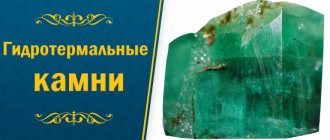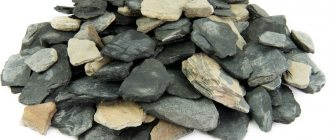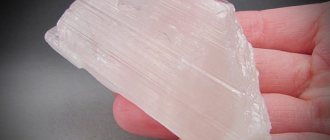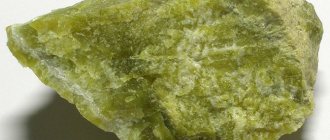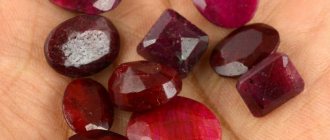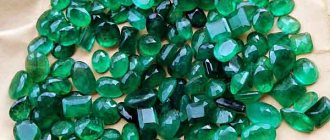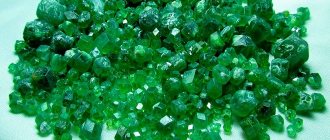Created using water and changing temperatures, the green crystal is called hydrothermal emerald or GT. But there are different types of synthetic stones, which we will also talk about in the article. Making artificial jewelry from jewelry production waste is very profitable. The dust remaining after cutting has exactly the same chemical composition as natural stone. Therefore, this material is best suited for making imitations.
Chromium gives green color
Modern technologies make it possible to obtain artificially grown emerald, which in its chemical and physical characteristics does not differ from natural ones. The use of such crystals reduces the cost of jewelry. Even representatives of not the most affluent segments of the population can buy an imitation that looks like a precious stone.
An emerald is a natural crystal of the beryl group containing chromium impurities. This metal gives the stone a green color, which becomes richer the more chromium atoms are placed in the crystal lattice.
If there are no chromium atoms in the structure, then the crystal loses color and is called beryl with the chemical formula Be3Al2Si6O18. Under natural conditions, the formation of an emerald requires that natural minerals containing beryllium, aluminum, silicon and chromium be exposed to high temperature and pressure for a long time.
How are emeralds grown?
What to explain, how hydrothermal emerald is obtained, what it is. The stone is artificial beryl. Natural raw materials are used in its production.
Hydrothermal emerald is obtained as follows:
- After jewelry cutting of a stone, a certain amount of powder remains. Beryllium and aluminum oxides and chromium are added to it.
- The resulting mixture should be placed in an autoclave.
- At the next stage, the raw materials are heat treated under high pressure.
- After this, the process of crystallization of the resulting solution begins.
The above stages (adjusted for the period) also have to go through natural gems obtained under natural conditions. Therefore, an artificial emerald produced through the use of hydrothermal technology is identical to stones mined from the depths of a mine or shaft.
Rare crystals with defects
Natural green emeralds are extremely rare, and the largest of them are much more expensive than pure diamonds.
The high price of faceted emeralds is also associated with the low quality of natural crystals, which have a large number of voids and cracks. When cut, the mineral loses up to 60% of its weight, and the cost of 1 carat reaches 8.5 thousand US dollars.
In such conditions, synthetic emerald, which has the same physical and chemical characteristics as natural, is becoming popular in jewelry production. It floods the market with products featuring stunning green crystals, which means the cost is greatly reduced. Read more in the article “Emerald in comparison with other stones.”
Main conclusions
- Hydrothermal emerald is an analogue of natural stone, grown from a beryl composition in special equipment.
- It has physical and chemical properties identical to natural minerals.
- Only an experienced specialist can distinguish hydrothermal stone from natural stone. Differences can be detected by studying a specimen using a microscope.
- Used in jewelry and industrial production. Gold and silver jewelry with nano-emerald are characterized by an affordable price and are offered in a wide variety.
- Despite its laboratory origin, it has healing energy that has a positive effect on humans. Can be used as a talisman. Zodiacally, emerald favors Cancer, Sagittarius, Leo, Taurus, Libra, Pisces.
Share your impressions of this mineral and leave feedback in the comments.
Artificially grown stones
Let's look at what kind of crystal is considered synthetic, how it is obtained and how significant the difference is in natural and artificial stones.
Several methods have been developed to create synthetic emerald. In the laboratory, silica is mixed with alumina or other substitutes, after which the required amount of chromium is added. The finely ground mixture is exposed to high temperatures and pressure, after which it is cooled.
The production of artificial emeralds is popular, but the resulting crystals do not have the characteristics of natural stone and are much cheaper than it.
It is much more practical to create an artificial emerald from the waste that is obtained after cutting the mineral. The resulting dust does not differ in composition from natural stone; it has exactly the same chemical composition as natural stone.
Next we will look at what hydrothermal emeralds are, and how they differ from natural stone.
Varieties
Hydrothermal emerald has a green tint. Provides it with the following parameters:
- chromium oxide;
- iron;
- vanadium.
The presence of these substances in the stone in different proportions allows the gem to be painted in different shades:
- warm yellowish-green tone;
- cold sea green color;
- blue-green color.
Hydrothermal emerald may contain brownish impurities, air bubbles, and tubular inclusions. However, artificial specimens are also found to be as transparent as possible. Depending on the given color, manufacturers can add certain additives when synthesizing artificial emerald.
Benefits of Hydrothermal Emeralds
To artificially grow crystals, which in their chemical composition do not differ from natural stones, waste that accumulates as a result of cutting emeralds is used.
The chips and emerald dust collected during cutting are delivered to the laboratory, where they are processed further. This waste is called working substrate and is the best material for the production of artificial crystals.
Jewelry dust is additionally crushed, mixed with water and treated in an autoclave with special chemicals. After exposure to high pressure and temperature during the cooling process, a small nanocrystal is grown on a special substrate, whose characteristics are practically no different from natural ones.
It takes four to five weeks to grow this nano emerald to industrial size in this way.
For the first time, the technology of artificial cultivation and imitation of emerald was developed by German scientists Perret and Otfel in 1888. It was kept a closely guarded secret until 1960, allowing the jewelry market to be saturated with green precious stones. The synthetic analogue differed little from the natural mineral and was of high value.
Jewelry with hydrothermal stones
Today, jewelers produce a large number of different jewelry with nano emeralds, the stone goes well with frames made of gold and silver, and now products made of white gold with synthetic gems, which look impressive and expensive, are considered very stylish and fashionable.
Rings, pendants, bracelets, earrings with hydrothermal emerald, and other jewelry may well be suitable for everyday wear, since the synthetic gem is more durable than the real one and is more resistant to ultraviolet rays. But still, a product with an artificially grown mineral should be protected, since it reacts poorly to the influence of various chemicals, for example, household appliance cleaners, some types of soap, etc.
Jewelry with a real nugget should be reserved for special occasions, as, despite its natural beauty, it is quite fragile and may not withstand everyday use.
Features of the technology
Unlike natural emeralds, hydrothermal emerald has virtually no internal defects due to its high growth rate. To detect differences, you need to use a magnifying glass with tenfold magnification or a special light filter.
The natural mineral will glow red and have a large number of voids. As a result, the hydrothermal emerald created through synthesis looks much more presentable. There are no voids in it, a uniform green tint means that you are looking at a crystal that was helped to grow in laboratory conditions. Read more in the article “How can you distinguish a real emerald from an artificial one.”
Modern technologies make it possible to control the hydrothermal regime at each stage of crystal growth. Even at home, specialists can grow a nano emerald, the properties of which will fully correspond to the programmed parameters. Read more in the article “Is it possible to grow emeralds at home?”
History and essence of the technological process
The processes of stone recrystallization in an artificial environment are not only a brilliant way out for people who cannot afford to purchase expensive jewelry. This is how priceless natural resources are used wisely.
It is known that in the process of sorting mined emeralds, experts try to find a use for all the material. For example, a small crystal can also be cut by an experienced jeweler, and in combination with other stones it can become a wonderful addition to jewelry. As for the fine chips and dust, it is precisely this material that is used as “raw material” in order to create a hydrothermal emerald. In addition to dust and small crumbs, experts often use beryllium silicates, which are part of natural specimens, as a basis.
The first nano emerald, the development of which was a great success for mankind, was created at the end of the 19th century by French scientists Hautefel and Perret. The method was improved a little later - in 1911, in Germany. For a long time, technological techniques and developments were kept in the strictest confidence, until the sixties of the last century. Obviously, this first experience and several subsequent ones were very valuable, but the quality of the first stones initially left much to be desired. Over time, the technology has been perfected, and what is now called synthetic emerald should not be confused with synthetic materials or cheap plastic. After all, the process itself is based on physical and chemical reactions that make it possible to improve the quality of laboratory specimens.
In Russia, similar technologies were developed and improved by a group of specialists led by gemologist Alexander Lebedev. Then the baton was passed to Alexey Ilyin, and a little later - to Dmitry Fursenko. He and his Western colleagues finally managed to obtain the first nanoemerald with excellent characteristics.
The process itself during which artificial emerald is grown is based on the use of water and high temperatures. The word “hydrothermal”, in this case, speaks for itself. Hydrothermal techniques, to some extent, can replace geothermal processes that occur in the bowels of the Earth and are one of the reasons for the appearance of natural minerals. Of course, humans cannot reproduce natural “technologies”. But thanks to the use of the necessary raw materials and the creation of certain conditions, it is possible to obtain a nano emerald, the properties of which will be quite high.
How to grow emerald in a laboratory environment and what exactly is “GT” technology? Stones are grown like this:
- Fine emerald dust, which remains after jewelry processing of larger minerals, is immersed in a special container (autoclave).
- The container contains a special composition that gradually acts on the raw material using high temperatures and certain chemicals.
- This is followed by cooling of the material, its crystallization begins and the minerals gradually settle onto a substrate made of high quality metal.
In general terms, it becomes clear what hydrothermal emerald is and how it is synthesized from suitable raw materials. By the way, the process itself has not undergone any significant changes over the years. Only the quality of the equipment used changes.
All production technology is concentrated in the hands of man, which means there is an excellent opportunity to endow this or that stone with the desired properties. For example, it is possible to produce a mineral that is purer and more transparent than many natural specimens. However, it is not possible to achieve their complete transparency. Crystallization, which takes place in laboratory conditions, follows the same path and the same principles as in the natural environment. It is practically impossible to control it completely. Therefore, any synthetic emerald will not have absolute transparency - just like a natural one.
This is why those people who call synthesized stones fake are deeply wrong. There are inclusions in both, and if you carefully look at the emerald against the light, you can see it right away, thereby eliminating cheap glass fakes.
In addition to the crystallization process, which can be called the “calling card” of the authenticity of the mineral, the remaining properties of the material can be changed at your discretion. If the temperature is properly controlled during the process of creating minerals, there is always the possibility of obtaining specimens that are almost impossible to distinguish from those that form in the natural environment. The desired weight and mass, as well as color, are obtained. People have learned to reproduce the legendary emerald green hue by enriching the source material by introducing chromium into it.
The best specimens were obtained when scientists introduced beryllium, alumina, silica, platinum and lithium dimolybdate into the original composition. All this was subjected to complex reactions at high temperatures using autoclaving. The result was stones whose characteristics turned out to be even better than those of natural emeralds.
It is known that hydrothermal minerals are resistant to high temperatures and sunlight, which is their undeniable advantage. They are also resistant to acids and better withstand possible mechanical damage.
Magical and healing properties of artificial emeralds
Experts say that even artificially grown emeralds have magical properties, just like natural emeralds. Many magicians use them to perform their own rituals.
Hydrothermal emerald is used to disinfect water. To do this, it is enough to place the stone in a container with water for 24 hours. In the future, such liquid can be safely consumed orally or used for washing. It is believed that such disinfection fills the water with energy.
Artificial or synthetic stone has no defects, is considered the standard of beauty and has a beneficial effect on the health of the owner. It is especially useful to keep such a crystal at home for people suffering from cardiovascular diseases.
In terms of internal energy, an artificial crystal is not much different from a natural one and is not suitable for every zodiac sign. It is strictly not recommended for Scorpios to carry it with them. And it will relieve Cancers and Geminis from hot temper, emotional stress and aggression. For a Taurus woman, it will strengthen her memory and help her concentrate on little things.
Read more in the article “Properties of the emerald stone, and who it suits according to their zodiac sign.”
WHAT ARE SUCH STONES NEEDED FOR?
The need to create artificial stones is determined by a number of reasons:
- Jewelry with natural stones is expensive: jewelry with hydrothermal emeralds is just as beautiful, but costs 70 times more.
- The processes of prospecting and mining of precious gems are labor-intensive and resource-intensive, while creating artificial stones in the laboratory is much simpler and cheaper.
- Natural resources are being depleted, and it is becoming more difficult to find deposits with new reserves of minerals.
- Artificially grown stones are used by jewelers of world fashion houses.
Magical and healing properties
Theoretically, artificially grown emerald crystals should have similar magical properties as natural ones. After all, a man-made mineral is created from similar components under the influence of similar processes.
Nano-emeralds are used for the same magical rituals as natural ones: for example, they disinfect water by placing the mineral in the liquid for 24 hours.
Medicinal qualities
These stones are also used for medicinal purposes.
For people
It is useful to have green gem jewelry:
- people suffering from heart disease,
- people susceptible to stress and respiratory problems.
For indoors
It is believed that if you store a green gem in your home, you can:
- protect yourself from bad energy;
- gain family well-being;
- get rid of attacks of anger;
- fill the house with love.
Green gems look good when set in rhodium-plated silver, platinum or white gold.
The frame emphasizes the beauty of emeralds, and the metal enhances the effect of the stone.
Can it be used as talismans?
Even an artificially grown gem has a certain energy.
Hydrothermal emeralds are used in the manufacture of talismans for the same reason as natural minerals: because raw materials from natural emeralds are used to create artificial gems.
We recommend: AMETHYST - stone of widows and bishops
Talismans made from green minerals help the owner in the following matters:
- will protect from damage with the evil eye;
- sailors will be protected from storms and storms;
- will organize your thoughts and calm you down.
Who is suitable according to Horoscope
The energy of crystals is not suitable for all zodiac signs:
- wearing hydrothermal jewelry is not recommended for SCORPIO;
- ARIES ensure success in business;
- TAURUS strengthens memory;
- GEMINI discover talents;
- CANCER and LIBRA help to find peace of mind;
- LIONS increase vital energy;
- CAPRICORN and SAGITTARIUS are relieved of mental anxieties, but these signs should not abuse the mineral;
- for PISCES and AQUARIUS it is a strong talisman that brings happiness and success.
Thailand artificial emeralds
Thanks to technologies for artificially growing crystals, within a short time it was possible to saturate the market with products with beautiful green emeralds. And the cost of jewelry was significantly reduced.
Jewelry from Thailand is especially popular, where gold and silver jewelry encrusted with precious stones is handcrafted. Thai tradition and low duties on imported gems allowed manufacturers to reduce prices for the best quality jewelry by almost 20%.
Gold-plated rings made of 925 silver, inlaid with natural emeralds cut in the form of an oval or baguette, have become very popular. They are of high value and not everyone is able to purchase such a gift.
Rings, earrings and pendants made of gilded silver with artificial crystals are much cheaper. Every tourist tries to bring such jewelry from Thailand, but people who do not understand gems will not see the difference and will not distinguish synthetic stones from natural ones.
How to distinguish a real emerald from an artificial one
Natural and laboratory gems are difficult to distinguish even for a professional.
Distinctive points:
- Hydrothermal emerald may have tubular inclusions, air bubbles, and brown impurities.
- Natural stone rarely has an ideal shape. More often – uneven, slightly cloudy (not perfectly transparent). Small cracks, defects, and inclusions are often visible.
- The artificial stone is absolutely transparent and has a deep, rich green color.
- A refractometer is capable of recording the difference in refraction. Natural stone has 1.58, artificial stone has 1.556–1.572.
It is easy to distinguish synthetic stone from glass fakes on your own at home or in a store. Imitation glass is easily damaged by a sharp object, unlike natural or grown stone. In addition, the glass quickly becomes warm in your hands, while the stone takes a long time to gain temperature.
If a layer of emerald has been applied to a glass fake, this can be seen when viewed from the side.
Watch the video review:
Visual exploration
Under a magnifying glass you can see the inclusions. It is important to be able to distinguish them from the bubbles that occur in glass counterfeits. But synthetic stones may not have inclusions.
The growth lines of synthetic stone are clearly parallel, while those of natural stone are a little chaotic. If a doublet or triplet (connections of stones) is presented, then traces of gluing can be detected.
Gems in a frame must be viewed from a distance of 2 meters. Fake stones will shine and shimmer; natural or grown stone has no reflections or shimmer, and looks like velvet.
Ultraviolet
Under ultraviolet light, like natural crystals, nano-emerald turns brownish-red.
Water
If you lower the test specimen into a glass of water, then:
- a red glow will indicate a fake;
- a bright green outline indicates low-quality beryl coated with artificial emerald;
- light background – about beryl;
- yellow tint - about peridot or green garnet;
- the sparks inside are about cubic zirconia.
Hardness
In terms of hardness, natural and laboratory-grown stones cannot be distinguished. But from glass it’s possible. Glass fakes may look worn because they wear out quickly. And they are damaged by a sharp object.
An inexperienced person cannot outwardly distinguish hydrothermal emeralds from natural ones. And their properties are identical. Therefore, it is wise to save on decoration by choosing a synthetic copy. But don't confuse it with a cheap fake.
Before purchasing, study the distinctive features of hydrothermal stones. Buy products in specialized stores. If in doubt, it is better to contact gemologists who will help determine the authenticity of the sample.
Have you ever compared hydrothermal and natural minerals? Share your experience in the comments. Tell your friends about the article via social networks. Stay tuned for new publications. All the best.
What is offered under the guise of emerald?
There are various substitutes for natural gems on the market:
- trade brands;
- imitations from cheap natural stones;
- doublets and triplets;
- artificial emerald;
- glass.
There are different ways to distinguish a fake in each case.
Trade brands
There are many products with the word emerald, but from other natural stones:
- evening emerald - rich yellow peridot, turning green in artificial light;
- Vilyuisky is the old name for brownish vesuvian;
- eastern – green sapphire;
- Pakistani – soft green garnet.
Similar minerals are also known as igmeralds, quintessae, simeralds, emerites. And smaragdolin is not a stone, but glass.
Imitations
Natural but cheap green gems from the second or third row, from alexandrite to zircon, are passed off as a high-class stone, such as emerald. They are bright, which makes them different from muted emerald.
These are refined tourmaline, synthetic cubic zirconia, quartz or spinel, natural jade or chrysoprase, as well as:
- demantoid is a rare, brightly shining Ural mineral;
- prehnite - calcium and aluminum silicate, representative of the third row;
- tsavorite – sparkling green garnet;
- chrysolite - semi-precious, resembles a noble stone in twilight lighting;
- fluorite is a mineral with the same inclusions as Colombian stones; under ultraviolet light it also glows red, but softer.
Less popular green gems are also used:
- giddenite;
- grossular;
- dioptase;
- jade;
- chrome diopside;
- uvarovite.
Often, an average-grade emerald is several times cheaper than an imitation of natural high-quality jade or demantoid.
Here the choice is between authenticity and quality.
Doublets and triplets
This imitation is several plates assembled into one pebble. The layers of fake stone are:
- low-grade emeralds;
- emerald plus other minerals (beryl, quartz, synthetic spinel);
- emerald plus other stones plus glass.
The material is joined with a special paste or glue to match.
Synthetic stones
Stone has always been counterfeited, but it was a clumsy job. The problem became serious at the end of the 19th century, when German specialists grew the first emerald. The process is being improved, the characteristics of natural and man-made stones are becoming closer. For example, it is impossible to distinguish them by hardness or luminescence under ultraviolet light.
However, synthetics have no cracks and are indifferent to sunlight or strong impacts.
Glass
The most popular of the fakes, this is usually painted bottle glass.
Production technology
Nano sapphires and emeralds are jewelry stones, the high quality of which is explained by a special production technology. The purpose of artificial cultivation is to reduce the cost of obtaining high-quality minerals.
Be sure to see: Origin, properties and magical power of alpanite
The first gem identical to natural was obtained in 1888 by scientists Perret and Otfel. The proven hydrothermal technology was improved in 1911 by German jewelers. The method of obtaining analogues of natural emeralds was kept secret until 1960.
Features of the technology for growing hydrothermal stones:
- Autoclaves are used - special ovens divided into cold and hot exposure zones.
- The seed for obtaining an analogue of natural minerals is a mass of beryl crushed or turned into dust. The raw material is usually left over after processing high quality crystals.
- Craftsmen add vanadium and chromium to the base raw materials. These chemical elements give the crystals their characteristic emerald color.
- A mixture of beryl, vanadium and chromium is placed in the hot zone of the autoclave. Here the workpiece dissociates in water. This process takes several days. High temperature is necessary for crystallization.
- Afterwards, the future gem is introduced into a cold environment using a seed substrate.
In the process of growing hydrothermal emerald, it is possible to regulate the shape, shade, uniformity of color and crystal size. This allows you to obtain gems of reference quality, which are extremely rare in nature and take centuries to form.
Differences between hydrothermal stones and natural ones
An experienced gemologist will find visual differences between minerals. If the specimen is grown in a laboratory, tubular inclusions and microscopic air bubbles will be visualized in its structure. The nanostone may contain a small amount of iron oxide, which cannot be said about a natural crystal.
Interesting! Gems obtained from nature have chips, cracks, and opaque areas, and this is considered normal. Hydrothermal emerald is ideal, since the process of obtaining it is completely controlled by man.
Physicochemical characteristics
Nanoemerald has the same physical and chemical properties as natural stone:
- hexagonal system;
- the shade varies from pale green to rich;
- characterized by a conchoidal fracture;
- the mineral is transparent, with a characteristic glassy luster;
- the hardness index on the Mohs scale reaches 8 points;
- the density does not exceed 2.78 g/cm3, therefore it is characterized by fragility;
- It is resistant to temperatures up to 650 degrees Celsius.
Minerals differ in their sensitivity to ultraviolet radiation: natural emerald loses its color saturation with prolonged exposure to rays, while nanostone retains its original appearance.
Be sure to see: Man-made jewel - artificial diamond
Application
Hydrothermal emeralds are used in jewelry and industry.
Do you love the perfect shape of a hydrothermal emerald?
In the jewelry industry
stone is a valuable raw material for the jewelry industry. unlike crystal of natural origin, it has a more affordable price. hydrothermal emerald is inlaid with silver and gold rings, earrings, men's rings, pendants, brooches, cufflinks, and watches. the mineral in products can be combined with cubic zirconia, crystal, sapphires and other gems.
The cost of jewelry with nanoemerald depends on the type of precious metal, the degree of complexity of the master jeweler’s work, the presence of other precious stones, and brand recognition.
in industry
Due to its high hardness, it is used in the space industry, electrical engineering, and nuclear energy for the production of various microcircuits and parts of complex mechanisms.
Who is suitable for hydrothermal emeralds?
Stones grown in the laboratory contain natural raw materials. Therefore, hydrothermal crystals are endowed with living energy, used in esotericism and lithotherapy.
Who is it suitable for?
When choosing jewelry with artificially produced emerald, you need to find out what the energy of the gem means for each zodiac sign. She favors Taurus, Cancer, Leo, Sagittarius, Libra and Pisces.
Interesting! Emerald will help representatives of these signs realize all their endeavors and gain self-confidence. Impulsive individuals will become calmer and more rational in their judgments and actions. It has a neutral effect on representatives of other signs.
Magic properties
Hydrothermal emerald helps maintain peace and prosperity in the family. This means that it is recommended to store products with it in a visible place in your home, because the stone neutralizes negative energy.
If you wear jewelry with a gem to an important business meeting, you can achieve success in negotiations. Emerald is a stone of truth, therefore it helps its owner to protect himself from communication with deceivers and dishonest people.
In case of anxious thoughts, it helps to cleanse the mind of negativity.
Esotericists use the gem in rituals aimed at healing. Thus, drinking water infused with green crystals helps cleanse the body of toxins, improve immunity and recharge with vigor.
Not suitable for individuals who are characterized by greed, unscrupulousness, and a penchant for scams. Emerald will harm such people, as it will bring only troubles into life.
Can it be used as talismans?
Crystals grown from natural raw materials in the laboratory can be used as talismans. They, like natural minerals, are endowed with healing energy. But there is an opinion that it is not as strong as that of a specimen formed in natural conditions.
When choosing a talisman mineral, you should listen to your feelings. If contact with a stone causes moral discomfort, deterioration of well-being and irritability, such a talisman should not be worn.
Main conclusions
- Hydrothermal emerald is an analogue of natural stone, grown from a beryl composition in special equipment.
- It has physical and chemical properties identical to natural minerals.
- Only an experienced specialist can distinguish hydrothermal stone from natural stone. Differences can be detected by studying a specimen using a microscope.
- Used in jewelry and industrial production.
Gold and silver jewelry with nano-emerald are characterized by an affordable price and are offered in a wide variety. - Despite its laboratory origin, it has healing energy that has a positive effect on humans.
Can be used as a talisman. Zodiacally, emerald favors Cancer, Sagittarius, Leo, Taurus, Libra, Pisces.
Share your impressions of this mineral and leave reviews in x.
Who is suitable for hydrothermal emerald according to their zodiac sign?
Depending on the zodiac sign, a beautiful gem appears in different ways:
For Aries, symbolizing active manifestation in the world, this stone will bring a guarantee of success in business. If you wear a ring with an artificial stone to a business meeting, the outcome of the transaction will exceed all expectations.
To Taurus, symbolizing freedom, the stone gives vital energy. The owner of the stone is guaranteed to feel an unprecedented surge of strength and activity.
For Gemini, the stone is considered a kind of discoverer of talent and excellent protection against the evil eye.
Synthetic emeralds help Cancers get rid of hypertension and find peace of mind.
Leo is a life-giving sign, and an artificial gem gives it an increase in vital energy.
Libra and Virgo are best suited for earrings with emeralds. They bring them spiritual harmony and help them cope with possible thyroid diseases.
Scorpios are quite powerful and vain representatives of astrological signs. Stone bracelets and earrings help them balance their inner world and calm their temper.
Capricorns and Sagittarius should wear jewelry with this gem no more than 3-4 times a week. This will be enough for inner peace, balance and relief from mental anxieties.
For Pisces and Aquarius, the stone brings unprecedented success and promotes happiness. It is for representatives of these signs that the hydrothermal emerald is the most powerful talisman and amulet.
Natural emerald
The formation of natural emeralds, as well as other precious stones, is an accident. A coincidence of many conditions is required for nature to create such a miracle as a crystal from what we are accustomed to calling earth, and geologists call rock.
It is required that at one point in space and time a lot of conditions coincide: temperature, pressure, beryllium, chromium and vanadium salts, and all this in certain parameters and ratios.
It is not surprising that natural emerald jewelry is very rare and highly prized.
Characteristics
Natural stones are evaluated according to 4 standard characteristics - color, clarity, weight and cut quality. Similar characteristics of hydrothermal emeralds are often no worse.
Color
The color of hydrothermal emerald is its main characteristic. It depends on the technology used: for a long time it was possible to obtain only dark green stones, but in the last decade the possibilities of the method have expanded. Color is described using 3 components: hue, saturation and lightness.
Colombian hydrothermal emeralds are green with a bluish tint. They are very similar to the stones mined in Colombia. In jewelry, emeralds of this color are considered standard and are valued above all.
Zambian hydrothermal emeralds are stones of a rich, dense green color. They are less known than the Colombian ones, but are also highly valued. The technologies for synthesizing such stones are simpler, which makes them more accessible.
RusGems Colombian emerald grown by hydrothermal method
Purity
The vast majority of natural emeralds have characteristic inclusions. Almost all the stones that can be seen on the display of a jewelry store are refined: they are impregnated with vegetable oils or polymer resins to fill cracks.
Hydrothermal emeralds can also have inclusions, but they are fewer and less noticeable. It is by the number and nature of inclusions that it is usually possible to distinguish a synthesized stone from a natural one.
Weight
The weight of a hydrothermal emerald depends on the time spent growing it. The longer the crystal grows, the larger it will be.
When selling synthesized stones, it is customary to indicate not the mass, but the dimensions. Based on them, it is easy to calculate the carat value of a particular specimen.
Cut shape
A pair of RusGems hydrothermal emeralds in a pear cut.
In the process of cutting a natural emerald, up to 95% of the original weight is lost. To preserve as much of the precious raw material as possible, the cutter has to deviate from the standard. Because of this, the cutting of natural stones is often far from ideal.
This is not the case with hydrothermal emerald: it can be shaped into the desired shape without worrying about leftover material. The most popular cuts are emerald, oval, and pear. They emphasize the beauty of the stone, its shade and color saturation.
Emerald check
According to the Fersman system of energy coefficients, emerald belongs to valuable gems of the first order.
Determining the authenticity of an emerald
You need to pay attention to the following features:
- Color.
- Transparency (the inside of the gem may be cloudy).
- Green tone.
The presence of additional color inclusions. The color of the original stone is not monochromatic. The richer and brighter the color, the higher the value of the stone.
If cloudiness occurs, you need to determine its origin:
- Air bubbles;
- Parts of other minerals;
- due to microcracks - either created by nature or appeared during processing.
